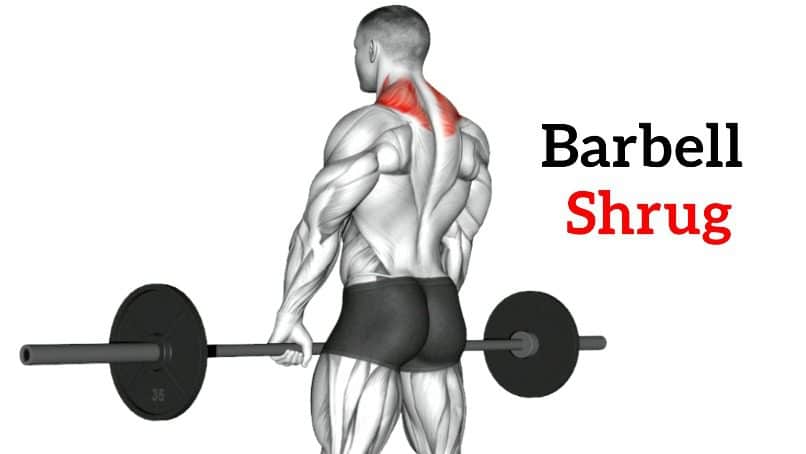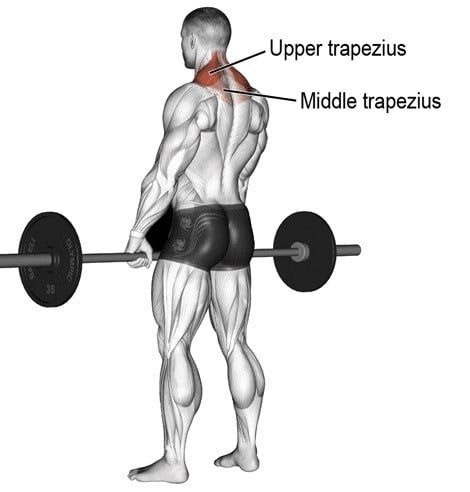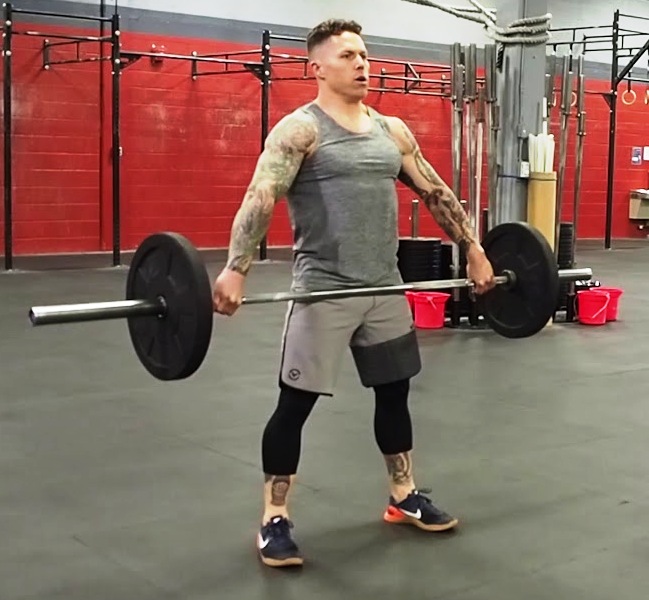You’re aware that the most effective way to build up your traps is by consistently doing barbell shoulder shrugs during your workout routine.
Barbell Shrugs, also known as barbell shoulder shrugs, are a popular choice of exercise for strengthening your Trapezius, upper back, shoulder muscles, neck, and upper arms too. It also helps to improve posture.
Shrugging weight is a great way to develop your traps and give you a healthier upper back overall. The barbell is especially beneficial for this goal because you can load up a lot of weight onto your traps.
Since both sides of your body are working together to move the same load, you will be able to move much more.

- Barbell Shrug Benefits
- Muscles Worked During Barbell Shrug
- How to Do Shrug With Barbell
- Reps, Sets, And Frequency For Barbell Shrug
- For Beginners
- For Intermediate
- Advanced:
- Barbell Shrug Form and Tips
- Barbell Shrug Variations
- 1. Snatch Grip Barbell Shrugs
- 2. Behind-the-Back Barbell Shrug
- Warm-up Exercises Before Barbell Shrug
- 1. Scapular Retraction
- 2. Shoulder Circles
- 3. Arm Swings
- 4. Neck Rotations
- What Are The Best Barbell Shrug Alternative
- 1. Dumbbell Shrug
- 2. Barbell Upright Row
- 3. Dumbbell Upright Row
- 4. Cable Upright Row
- Frequently Asked Question
- 1. Do barbell shrugs work shoulders?
- 2. Do barbell shrug work neck
- 3. Barbell shrug reps and sets.
- Takeaways
- References
- Trap Exercises Including Shrug and Upright To Build Bigger Traps
Barbell Shrug Benefits
Building strong shoulders is proper shoulder strength is crucial for a stronger and healthier upper body, and the shoulder shrug can produce benefits that translate to your overall gym performance and your everyday life.
Here are the benefits of a barbell shoulder shrug exercises :
- It is the best exercise to train the upper back and shoulders, especially the trap muscles.
- The exercise is great for upper body stability and conditioning.
- It helps to improve grip strength and forearm development.
- A study has shown that shrugging helps relieve shoulder and neck pain. Strengthening your traps helps provide better support to your head and neck by increasing the activation of your shoulder muscles.
- Building traps is a challenging task. The Barbell shrug is one of the few exercises that mainly work your traps.
- It helps build strength in your upper body stabilizer muscle groups, helping you stand up tall and keep your back straight.
- It is good for strength in the posterior chain. The posterior chain includes the muscles of the rear from top to bottom.
Muscles Worked During Barbell Shrug
The trapezius muscle is a large, triangular muscle that spans the upper back and shoulders. It plays a key role in shoulder movement and stability, as well as in maintaining proper posture.
The trapezius muscle can be divided into three parts. Together, the three parts of the trapezius help you move your head, stand up straight, bend or twist your torso and raise your arms.
- Upper fibers (Upper trapezius)
- Middle fibers (middle trapezius)
- Lower fibers (Lower trapezius).
You obviously want to know which muscle groups are worked by the barbell shrug, which will determine which day it fits into your routine.
Here are the muscles it works.
- The main muscles worked during the barbell shrug are the upper traps.
- The secondary muscle (synergist Muscles) worked during barbel shrug is a middle trap.
- Likewise, shrugs train the levator scapulae, a muscle that you can feel if you put your hand right on the side of your neck.
- The stabilizer muscles worked during shrug are core and erector spinae.

How to Do Shrug With Barbell
The front barbell shrug is one of the best exercises to build bigger, stronger trapezius muscles. This exercise can be done extremely heavily to thicken the traps that really help you in doing back poses.
The front barbell shoulder shrug exercise is one of the most simplistic and easy trap exercises to perform.
- Stand with feet placed shoulder-width apart, knees slightly bent, and core stable.
- Grip the barbell with your hands facing downwards in a pronated grip.
- Raise your shoulders without bending the elbows as far as possible, getting them closer to your ears.
- Hold the contraction and squeeze for a brief second. In a controlled and stable manner, lower the weight back down to the starting position.

Know More: 20 Best Trap Workout and Exercises for Mass and Strength
Reps, Sets, And Frequency For Barbell Shrug
The barbell shrug is good for both high and low repetitions.
- For muscle hypertrophy (muscle growth): Aim for a rep range of 8-12 reps per set
- For strength and power: Lower the rep range to around 4-6 reps per set.
- For Endurance: Do 15-20 reps per set.
However, here are some general guidelines to help you get started:
For Beginners
- Reps: Start with 8-10 repetitions per set.
- Sets: Perform 2-3 sets of the exercise.
- Frequency: Include the exercise in your shoulder workout routine 1-2 times per week.
For Intermediate
- Reps: Aim 10-15 repetitions per set.
- Sets: Aim for 3-4 sets of the exercise.
- Frequency: 2-3 times per week.
Advanced:
- Reps: Increase the challenge by performing 12-20 repetitions per set.
- Sets: Perform 4-5 sets of the exercise.
- Frequency: 2-3 times per week.
Barbell Shrug Form and Tips
- While shrugging, looking slightly up may enhance the contraction.
- The motion should be smooth and controlled, as a jerky motion could result in a neck injury.
- Don’t let the head move forward too much when you’re squeezing the traps. This can hurt the neck.
- Go full range. Only move the shoulders and keep the rest of the body steady.
- Adding a pause at the top of the movement can help to strengthen the mind muscles.
- Try to raise the weight as high as possible without causing too much momentum or excessive jerking or bouncing of the weight.
- Your hands should be slightly wider than shoulder-width.
- Please avoid attempting to lift the barbell with your biceps.
- The bar should move in a straight line upwards and downwards, so don’t roll your shoulders.
- The traps do well when you do high repetitions and do hard movements like snatch grip shrug. You could try your extra exercises around it.
- Go heavy, but use a weight that allows you to perform more than 12 reps per set.
- Because traps are a stubborn muscle group for many, they can be trained with a fairly high frequency during the week.
Barbell Shrug Variations
If you’re tired of doing front barbell shrugs, or you want to add some variety to your next upper body workout, you can do front barbell shoulder shrugs in many ways that each have their benefits.
1. Snatch Grip Barbell Shrugs
Snatch grip barbell shrugs are a variation of the traditional barbell shrug exercise, where the grip is widened to a snatch grip position. This means placing your hands much wider on the barbell than you would for a standard barbell shrug.
The wider grip in snatch grip barbell shrugs allows for a greater range of motion, leading to increased activation of the upper back muscles, including the traps and rhomboids.

How to Do Barbell Snatch Grip Shrugs
- Stand with your shoulders wide apart and your feet slightly outward.
- Grasp the barbell with a wide snatch grip, where your hands are positioned significantly wider than shoulder-width apart.
- Keep your arms fully extended and maintain a neutral spine.
- Lift the barbell by driving through your heels, keeping your back straight and shoulders pulled back.
- Elevate your shoulders as high as possible, squeezing your traps at the top.
- Hold the barbell in the top position for a moment, and then slowly lower it back to the starting position.
- Repeat for the desired number of repetitions.
Want to take your gains to the next level? Discover your daily calorie needs with our free TDEE calculator
2. Behind-the-Back Barbell Shrug
The barbell behind-the-back shoulder shrug is a variation of the front barbell shrug that mainly works the upper traps. Having the bar behind you helps in keeping your shoulders pulled up and back rather than rounded forward.
It is popular in strength and muscle-focused upper-body training and is often trained on a shoulder day.
The barbell behind-the-back is usually performed for moderate to high reps, such as 8-12 reps per set or more, as part of shoulder training or trap-focused training.

How To Do Behind-the-Back Barbell Shrug
- Stand tall with your feet shoulder-width apart.
- Hold the barbell with a pronated grip (palms facing backward) and hands positioned slightly wider than shoulder-width apart, behind your body at hip level.
- Keep your back straight and your chest lifted. Engage your core for stability.
- Lift your shoulders toward your ears as high as possible while keeping your arms straight.
- Hold the contraction for a second before lowering the bar back to the starting position.
- Repeat for the desired number of repetitions.
Know More: Shrug Exercise: Benefits, Variations, Muscles used, Tips
Warm-up Exercises Before Barbell Shrug
Before you start doing heavy barbell shrugs, it is important to warm up properly. Warming up can help boost blood flow to your muscles, make your joints more flexible, and lower the chance of getting hurt.
Here are some exercises to warm up before doing barbell shrugs:
1. Scapular Retraction
Scapular retraction is a great warm-up exercise for the trapezius muscles. To perform scapular retraction,
- Stand with your arms at your sides and your shoulders relaxed.
- Pull your shoulder blades back and down, squeezing your shoulder blades together.
- Hold for a few seconds, then release. Repeat for 10-12 reps.
You can also try these warm ups exercises:
2. Shoulder Circles
Circular movements of the shoulders can boost blood flow to the shoulder joint and enhance flexibility.
- Stand with your arms at your sides and your shoulders relaxed.
- Slowly circle your shoulders forward, then backward. Repeat for 15-20 reps.
3. Arm Swings
Arm swings have the potential to stimulate the trapezius muscles and prepare them for heavier lifting.
- Stand with your feet shoulder-width apart and your arms at your sides.
- Swing your arms forward, then backward, keeping them straight. Repeat for 10-15 reps.
4. Neck Rotations
Neck rotations are a simple and effective warm-up exercise to loosen up the neck muscles and increase mobility.
- Gently rotate your neck in a circular motion, first clockwise and then counterclockwise.
- Start with small circles and gradually increase the size. Perform 5-8 rotations in each direction.
What Are The Best Barbell Shrug Alternative
Before we deep dive into the best barbell shrug alternatives. We must remember, a good front barbell shrug alternative will be able to satisfy the following criteria:
- Activate the trapezius muscle groups, which is trained in the shrug barbell.
- Isolate the muscle groups during execution
- Train the trapezius muscle through a longer range of motion
1. Dumbbell Shrug
Dumbbell shrugs are similar to barbell shrugs but use dumbbells instead. It is one of the best exercises to build bigger, stronger trapezius muscles.
Dumbbell shoulder shrug exercise can be done heavily to thicken the traps that really help you in doing back poses. This is one of the best isolation exercises for the trapezius muscle.
Traps, being a stubborn muscle group for many, can be trained with a fairly high frequency during the week.
2. Barbell Upright Row
The barbell upright Row is an excellent exercise to build huge Trapezius muscles. Upright rows along with shrugs build massive traps. You can use either a smith machine, free weights, or cable to perform upright rows.
Barbell upright rows can be done with both narrow grips and wider ones.
- The narrow grip focuses on the trapezius,
- And the wider focuses on the entire shoulder girdle.
Moreover, the wider grip allows some cheating movement, thereby allowing you to lift more weight.
3. Dumbbell Upright Row
The dumbbell upright row is the best alternate of barbell shrug to develop the middle and the upper traps.
Using dumbbells in the upright row can help to increase unilateral muscle development and address any asymmetries and movement imbalances as well.
4. Cable Upright Row
The cable upright row is a movement that targets many of the large muscles in the upper back and shoulders, which is key for many movements (see below) in strength, power, and fitness sports.
Upright rows are an exercise that nearly everyone can do using a wide variety of grip widths.
Cable machines keep tension on the muscles throughout the entire range of motion, ultimately increasing muscle activation and hypertrophy.
Frequently Asked Question
1. Do barbell shrugs work shoulders?
Barbell shrugs work the trapezius muscles, and the shoulders are also involved to a pretty decent degree.
2. Do barbell shrug work neck
Yes, as the upper muscle fibers of the traps are responsible for upward rotation and extension of the neck. Hence, when you train the trap muscle, it also strength the neck muscles.
3. Barbell shrug reps and sets.
4-5 sets of 8-12 reps each, 60 seconds rest
Takeaways
The barbell shrug proves that good things can come in small packages. Although the shrug is a humble movement, it can have remarkable consequences for the overall development of our upper bodies.
If you’re looking to turbocharge your trap gains, implement barbell shoulder shrugs into your workouts, and you’ll have a stronger, bigger, and more resilient upper body.
References
- Shrug exercises combined with shoulder abduction improve scapular upward rotator activity and scapular alignment in subjects with scapular downward rotation impairment.
- Exercise Modifications and Strategies to Enhance Shoulder Function.
- Trapezius muscle latency with and without impingement symptoms.
- Modifying a shrug exercise can facilitate the upward rotator muscles of the scapula
Trap Exercises Including Shrug and Upright To Build Bigger Traps

Manish brings over 10 years of hands-on experience in weight lifting and fat loss to fitness coaching. He specializes in gym-based training and has a lot of knowledge about exercise, lifting technique, biomechanics, and more.
Through “Fit Life Regime,” he generously shares the insights he’s gained over a decade in the field. His goal is to equip others with the knowledge to start their own fitness journey.
